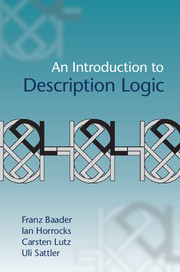Book contents
- Frontmatter
- Contents
- 1 Introduction
- 2 A Basic Description Logic
- 3 A Little Bit of Model Theory
- 4 Reasoning in DLs with Tableau Algorithms
- 5 Complexity
- 6 Reasoning in the EL Family of Description Logics
- 7 QueryAnswering
- 8 Ontology Languages and Applications
- Appendix Description Logic Terminology
- References
- Index
1 - Introduction
Published online by Cambridge University Press: 13 June 2017
- Frontmatter
- Contents
- 1 Introduction
- 2 A Basic Description Logic
- 3 A Little Bit of Model Theory
- 4 Reasoning in DLs with Tableau Algorithms
- 5 Complexity
- 6 Reasoning in the EL Family of Description Logics
- 7 QueryAnswering
- 8 Ontology Languages and Applications
- Appendix Description Logic Terminology
- References
- Index
Summary
This is, to the best of our knowledge, the first textbook dedicated solely to Description Logic (DL), a very active research area in logic-based knowledge representation and reasoning that goes back to the late 1980s and that has a wide range of applications in knowledge-intensive information systems. In this introductory chapter we will sketch what DLs are, how they are used and where they come from historically. We will also explain how to use this book.
What are DLs and where do they come from?
Description logics (DLs) are a family of knowledge representation languages that can be used to represent knowledge of an application domain in a structured and well-understood way. The name description logics is motivated by the fact that, on the one hand, the important notions of the domain are represented by concept descriptions, i.e., expressions that are built from atomic concepts (unary predicates) and atomic roles (binary predicates) using the concept and role constructors provided by the particular DL; on the other hand, DLs differ from their predecessors, such as semantic networks and frames, in that they are equipped with a logic-based semantics which, up to some differences in notation, is actually the same semantics as that of classical first-order logic.
Description logics typically separate domain knowledge into two components, a terminological part called the TBox and an assertional part called the ABox, with the combination of a TBox and an ABox being called a knowledge base (KB). The TBox represents knowledge about the structure of the domain (similar to a database schema), while the ABox represents knowledge about a concrete situation (similar to a database instance). TBox statements capturing knowledge about a university domain might include, e.g., a teacher is a person who teaches a course, a student is a person who attends a course and students do not teach, while ABox statements from the same domain might include Mary is a person, CS600 is a course and Mary teaches CS600. As already mentioned, a crucial feature of DLs is that such statements have a formal, logic-based semantics.
- Type
- Chapter
- Information
- An Introduction to Description Logic , pp. 1 - 9Publisher: Cambridge University PressPrint publication year: 2017



